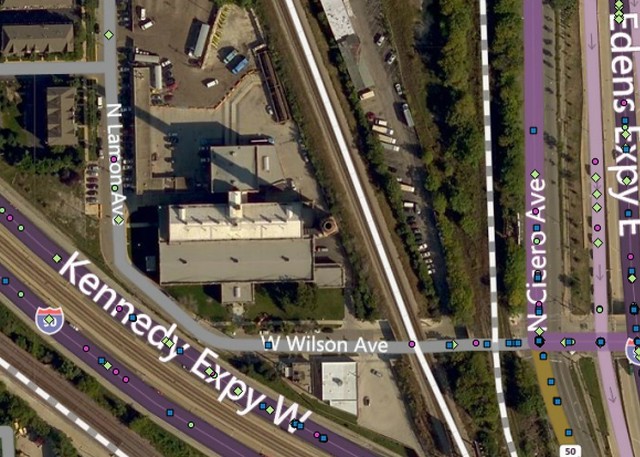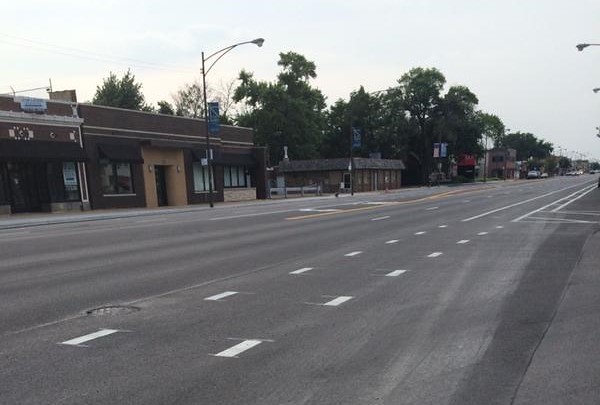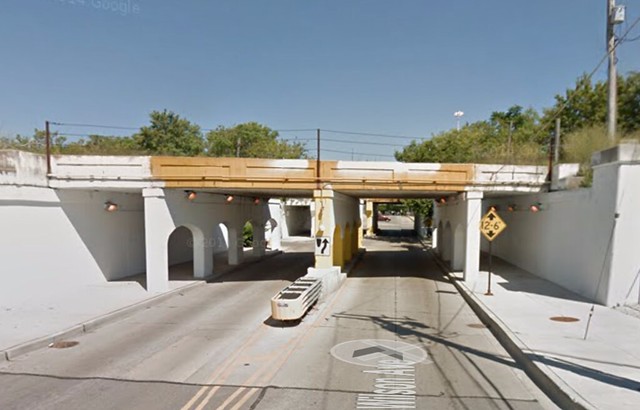
Two weeks ago, 45th Ward Alderman John Arena used his car to blockade a construction site at Wilson Avenue and Lamon Avenue, where a Chicago Department of Transportation crew had begun building cul-de-sacs to eliminate through traffic and make room for a digital billboard. Arena, who opposes the installation of the 90-foot sign, said he wasn’t notified about the street closure work before it started the previous weekend. The alderman also argued that the street closure would cause traffic problems.
In the wake of the alderman’s direct action, CDOT spokesman Mike Claffey said the decision to build cul-de-sacs was in response to “a history of excessive speeding on Lamon and Wilson due to cut-through traffic”:
These improvements, while addressing traffic safety and improving conditions on the increasingly residential section of Lamon, also accommodate the placement of a digital sign which was approved by City Council in 2013…These changes will address the speeding problem, eliminate crashes from cars that lose control at the curve from Lamon to Wilson, and reduce the number of trucks that strike the low-clearance viaduct on Wilson.
The department met with Arena that day and agreed to halt the project and temporarily reopen the street until a public meeting can be held about the street closure. Car access has been restored but, last week, Arena’s chief of staff Owen Brugh told me that the ward had not yet received speeding and crash statistics from CDOT that would back up the safety argument, and the public meeting hasn’t been scheduled.
I asked the transportation department for relevant crash data but they didn't provide any. Instead, Streetsblog Chicago’s Steven Vance looked up the information in the Illinois Department of Transportation’s crash database, called the Illinois Safety Data Mart which is based on Chicago Police Department reports. The database is currently offline, but Steven requests the data from IDOT each year and uses it to update his website the Chicago Crash Browser.
Only crashes resulting in serious injury or at least $1,500 in property damage are included in the IDOT database. Here’s what Steven found from looking at the data from 2009 to 2013 on Lamon and Wilson between Lawrence Avenue and Cicero Avenue, excluding crashes within Lawrence and Cicero.
Between Lawrence and a viaduct for Metra’s Milwaukee District / North Line (the solid-white, diagonal line west of Cicero in the above aerial), there were five crashes, all involving car drivers who struck parked cars, resulting in property damage but no reported injuries:
- 2010: July 22, 9:50 p.m. -- crashed into parked car
- 2011: Janury 6, 12:30 p.m. -- crashed into parked car
- 2011: August 9, 5:30 p.m. – crashed into parked car
- 2012: October 6, 6 a.m. – crashed into parked car
- 2013: August 26, 2 p.m. -- crashed into parked car due to "operating vehicle in erractic / reckless / careless / negligent or aggressive manner"
Between the Metra viaduct and Cicero – a short stretch which includes a second viaduct for two unused rail lines (shown on the aerial as the dashed line just west of Cicero) -- there were nine crashes, all resulting in property damage but no reported injuries:
- 2009: February 9, 2:20 p.m. -- semi-truck without a trailer hit the viaduct underside
- 2010: May 3, 2:15 p.m. – SUV hit a fixed object while avoiding a vehicle
- 2010: June 3, 9:30 a.m. – single-unit truck hit the viaduct underside
- 2010: August 9, 9:37 a.m – single-unit truck hit the viaduct underside
- 2010: October 8, 7:30 a.m. – personal van/minivan hit a viaduct support
- 2010: October 23, 1:00 p.m. – two personal cars collided
- 2011: April 29, 4:01 p.m. – driver of a personal van/minivan turned left and hit a parked car
- 2012: July 25, 5:50 p.m. – driver doing a u-turn crashed into a through-traveling SUV
- 2012: August 2, 8:40 a.m. – semi-truck with trailer backed up and struck two parked cars
Of these nine crashes, three involved trucks hitting the underside of one of the 12’6”-high viaducts, and two or three more of these collisions involved vehicles striking the viaduct supports. This seems to back up CDOT’s claim that the low-clearance viaducts on Wilson are an issue. However, Brugh told me he believes viaduct crashes are more of a problem on Lawrence.
None of the 14 total crashes took place at the bend where Wilson meets Lamon, which may undermine the statement that drivers are losing control at this curve and crashing. On the other hand, three crashes took place just north of the bend, and one took place just east of the bend, which may support the claim. Another interesting stat is that all but one of the collisions took place during daylight hours.
The big question is whether 14 crashes over a five-year period, none of which resulted in serious injuries, represents an unusually high number that needed to be addressed by the street closure. To determine this, one would ideally look at streets with similar conditions, connecting two major streets and an expressway – the Edens lies just east of Cicero.
When I shared Steven’s findings with CDOT’s Mike Claffey last Friday, he declined to comment on them or provide additional data. “We are working on a comprehensive report on traffic in the area, which we will be sharing with the alderman and the community in the near future,” he said.
It seems likely that there are other streets in the 45th Ward with similar crash stats as the Wilson/Lamon area. It’s surely not a coincidence that CDOT is prioritizing safety improvements for this stretch where the city also wants to erect a digital sign in the street. Originally, the billboard plan called for installing it on the lawn of the adjacent Mayfair Pumping Station.
While cul-de-sac-ing Wilson/Lamon would probably result in a drop in crashes due to less traffic, it’s important that CDOT provides compelling evidence that the closure is needed for safety, not just advertising revenue. If there isn’t really a serious crash problem in the area, crying wolf would undermine the department’s future credibility when it proposes projects for the many other streets that have major speeding and collision issues.

One such street is Milwaukee Avenue, between Lawrence and Elston, in the 45th Ward. This 2.5-mile stretch saw 910 crashes between 2008 and 2012, resulting in at least 17 serious injuries and three deaths. CDOT originally proposed a robust road diet for the five-lane street, which would have converted it to two travel lanes and a turn lane, plus protected bike lanes.
Arena supported the idea, but after stiff opposition from residents, led by failed aldermanic challenger John Garrido, the road diet was severely watered down. The five lanes will stay in place with a slightly narrower layout, and CDOT is upgrading the existing conventional bike lanes to buffered lanes. The project should be done by this fall, Brugh said.
Updated Tuesday, August 4: The article was corrected to state that Steven requests new crash data from IDOT each year.





